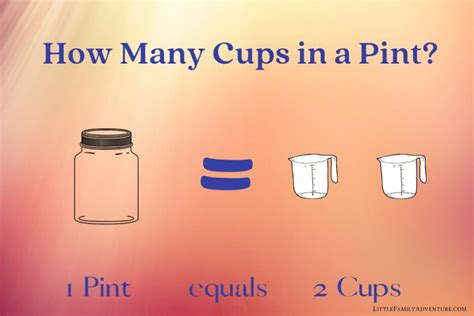6 Cups Is How Many Pints
Kalali
Mar 29, 2025 · 4 min read

Table of Contents
6 Cups is How Many Pints: A Comprehensive Guide to US and Imperial Liquid Measurements
Understanding liquid measurements can be tricky, especially when juggling different units like cups and pints. This comprehensive guide will delve deep into the conversion of cups to pints, clarifying the differences between US customary units and imperial units, and offering practical examples to solidify your understanding. We'll also explore the broader context of volume measurement and its importance in various applications.
Understanding Cups and Pints
Before diving into the conversion, let's establish a clear understanding of what cups and pints represent. Both are units of volume, used predominantly in cooking, baking, and other applications requiring precise liquid measurements.
Cups: A cup is a unit of volume, commonly used in recipes and everyday cooking. The size of a cup can vary slightly depending on the measuring cup used, but the standard measurement is generally accepted as 8 fluid ounces.
Pints: A pint is a larger unit of volume than a cup. It represents a collection of cups, making it a convenient unit for measuring larger quantities of liquids.
The Conversion: 6 Cups to Pints
The fundamental conversion factor is crucial here: 1 pint equals 2 cups. This is a constant regardless of whether you're using US customary or imperial units (although there are minor differences, as discussed later).
Therefore, to determine how many pints are in 6 cups, we simply divide the number of cups by the number of cups per pint:
6 cups / 2 cups/pint = 3 pints
Therefore, 6 cups is equal to 3 pints.
US Customary vs. Imperial Units: A Subtle Difference
While the basic conversion (2 cups = 1 pint) remains consistent, slight discrepancies can arise due to the differences between US customary units and imperial units. These differences are generally insignificant in everyday cooking and baking, but understanding them contributes to a more complete understanding of volume measurement.
The US liquid pint is slightly smaller than the imperial liquid pint. The difference is marginal, but it exists. While this minute variation rarely impacts everyday activities, it's crucial for precise scientific or industrial applications requiring extreme accuracy. For our purposes in converting 6 cups to pints, the difference is negligible.
Practical Applications and Examples
Understanding the conversion from cups to pints has numerous practical applications across various domains:
Cooking and Baking:
- Recipe Scaling: Imagine you have a recipe that calls for 6 cups of liquid and you want to double it. Knowing that 6 cups is 3 pints makes it easy to adjust the recipe accordingly, using pints as the unit for scaling.
- Ingredient Measurement: When dealing with larger batches of food preparation, using pints can streamline the measurement process, saving time and effort.
Everyday Life:
- Beverage Consumption: Tracking your daily fluid intake becomes simpler by using pints as a unit of measurement for liquids consumed.
- Household Projects: DIY projects often require liquid measurements for paints, stains, or other solutions. Understanding the cup-to-pint conversion ensures accuracy in following project instructions.
Scientific and Industrial Applications:
Although the difference is minor, precise conversions between US customary and imperial pints are critical in certain scientific and industrial contexts that require high accuracy and consistency.
Beyond Cups and Pints: Other Units of Volume
The world of volume measurement extends far beyond cups and pints. Understanding other units and their relationships allows for greater flexibility in handling different measurement scales. Here are some commonly used units:
- Fluid Ounces: A fundamental unit in the US customary system, with 8 fluid ounces equaling 1 cup.
- Quarts: Larger than a pint, with 2 pints equaling 1 quart.
- Gallons: The largest unit commonly used, with 4 quarts equaling 1 gallon.
- Milliliters (ml) and Liters (l): These metric units are widely used globally and provide a consistent and easily convertible system.
Understanding the relationships between these units, as well as their relationship to cups and pints, provides a comprehensive grasp of volume measurement.
Tips for Accurate Measurement:
- Use Standardized Measuring Cups and Jugs: Using accurate and well-calibrated measuring tools is crucial for precision.
- Level the Measurement: Avoid overfilling measuring cups. Ensure the liquid is level with the top of the cup for accurate readings.
- Understand Your Recipe's Unit System: Always check whether the recipe you are using employs US customary or imperial units to avoid confusion.
Conclusion: Mastering Liquid Measurement Conversions
The conversion from cups to pints, while seemingly simple, underpins a broader understanding of volume measurement. Knowing that 6 cups equals 3 pints not only facilitates cooking and baking, but also opens the door to more precise measurement in various contexts. By understanding the different unit systems and mastering the conversion process, you'll gain confidence and accuracy in all your measurement-related tasks. Whether you're a home cook, a DIY enthusiast, or a scientist, a solid grasp of volume measurement will serve you well. Remember, mastering these conversions is a key skill applicable to a wide variety of applications and contributes significantly to accuracy and efficiency in your work. Keep practicing, and soon you'll be converting units with ease!
Latest Posts
Latest Posts
-
Is Toasting A Marshmallow A Chemical Change
Apr 01, 2025
-
What Is The Electron Configuration For Te
Apr 01, 2025
-
What Is 9 16 In Decimal Form
Apr 01, 2025
-
How Many Inches Is 220 Centimeters
Apr 01, 2025
-
How Many Cups In 6 Fluid Ounces
Apr 01, 2025
Related Post
Thank you for visiting our website which covers about 6 Cups Is How Many Pints . We hope the information provided has been useful to you. Feel free to contact us if you have any questions or need further assistance. See you next time and don't miss to bookmark.
